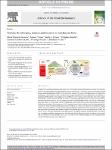Tritium: Its relevance, sources and impacts on non-human biota
| dc.contributor.author | Ferreira, MF | |
| dc.contributor.author | Turner, Andrew | |
| dc.contributor.author | Vernon, EL | |
| dc.contributor.author | Grisolia, C | |
| dc.contributor.author | Lebaron-Jacobs, L | |
| dc.contributor.author | Malard, V | |
| dc.contributor.author | Jha, Awadhesh | |
| dc.date.accessioned | 2023-04-17T10:39:13Z | |
| dc.date.available | 2023-04-17T10:39:13Z | |
| dc.date.issued | 2023-03-13 | |
| dc.identifier.issn | 0048-9697 | |
| dc.identifier.issn | 1879-1026 | |
| dc.identifier.other | 162816 | |
| dc.identifier.uri | https://pearl.plymouth.ac.uk/handle/10026.1/20706 | |
| dc.description.abstract |
Tritium (3H) is a radioactive isotope of hydrogen that is abundantly released from nuclear industries. It is extremely mobile in the environment and in all biological systems, representing an increasing concern for the health of both humans and non-human biota (NHB). The present review examines the sources and characteristics of tritium in the environment, and evaluates available information pertaining to its biological effects at different levels of biological organisation in NHB. Despite an increasing number of publications in the tritium radiobiology field, there exists a significant disparity between data available for the different taxonomic groups and species, and observations are heavily biased towards marine bivalves, fish and mammals (rodents). Further limitations relate to the scarcity of information in the field relative to the laboratory, and lack of studies that employ forms of tritium other than tritiated water (HTO). Within these constraints, different responses to HTO exposure, from molecular to behavioural, have been reported during early life stages, but the potential transgenerational effects are unclear. The application of rapidly developing “omics” techniques could help to fill these knowledge gaps and further elucidate the relationships between molecular and organismal level responses through the development of radiation specific adverse outcome pathways (AOPs). The use of a greater diversity of keystone species and exposures to multiple stressors, elucidating other novel effects (e.g., by-stander, germ-line, transgenerational and epigenetic effects) offers opportunities to improve environmental risk assessments for the radionuclide. These could be combined with artificial intelligence (AI) including machine learning (ML) and ecosystem-based approaches. | |
| dc.format.extent | 162816-162816 | |
| dc.format.medium | Print-Electronic | |
| dc.language | en | |
| dc.publisher | Elsevier BV | |
| dc.subject | Nuclear energy | |
| dc.subject | Tritium ( 3 H) | |
| dc.subject | Tritiated water (HTO) | |
| dc.subject | Environment | |
| dc.subject | Radiation dose | |
| dc.subject | Toxicity | |
| dc.subject | Risk assessment | |
| dc.title | Tritium: Its relevance, sources and impacts on non-human biota | |
| dc.type | journal-article | |
| dc.type | Journal Article | |
| dc.type | Review | |
| plymouth.author-url | https://www.webofscience.com/api/gateway?GWVersion=2&SrcApp=PARTNER_APP&SrcAuth=LinksAMR&KeyUT=WOS:000988034700001&DestLinkType=FullRecord&DestApp=ALL_WOS&UsrCustomerID=11bb513d99f797142bcfeffcc58ea008 | |
| plymouth.volume | 876 | |
| plymouth.publication-status | Published | |
| plymouth.journal | Science of The Total Environment | |
| dc.identifier.doi | 10.1016/j.scitotenv.2023.162816 | |
| plymouth.organisational-group | |Plymouth | |
| plymouth.organisational-group | |Plymouth|Research Groups | |
| plymouth.organisational-group | |Plymouth|Faculty of Science and Engineering | |
| plymouth.organisational-group | |Plymouth|Faculty of Science and Engineering|School of Geography, Earth and Environmental Sciences | |
| plymouth.organisational-group | |Plymouth|Faculty of Science and Engineering|School of Biological and Marine Sciences | |
| plymouth.organisational-group | |Plymouth|Research Groups|Marine Institute | |
| plymouth.organisational-group | |Plymouth|REF 2021 Researchers by UoA | |
| plymouth.organisational-group | |Plymouth|Users by role | |
| plymouth.organisational-group | |Plymouth|Users by role|Academics | |
| plymouth.organisational-group | |Plymouth|Research Groups|BEACh | |
| plymouth.organisational-group | |Plymouth|REF 2021 Researchers by UoA|UoA06 Agriculture, Veterinary and Food Science | |
| plymouth.organisational-group | |Plymouth|REF 2021 Researchers by UoA|UoA07 Earth Systems and Environmental Sciences | |
| plymouth.organisational-group | |Plymouth|Admin Group - REF | |
| plymouth.organisational-group | |Plymouth|Admin Group - REF|REF Admin Group - FoSE | |
| plymouth.organisational-group | |Plymouth|Users by role|Researchers in ResearchFish submission | |
| dc.publisher.place | Netherlands | |
| dcterms.dateAccepted | 2023-03-08 | |
| dc.date.updated | 2023-04-17T10:39:12Z | |
| dc.rights.embargodate | 2023-4-18 | |
| dc.identifier.eissn | 1879-1026 | |
| dc.rights.embargoperiod | forever | |
| rioxxterms.versionofrecord | 10.1016/j.scitotenv.2023.162816 |


